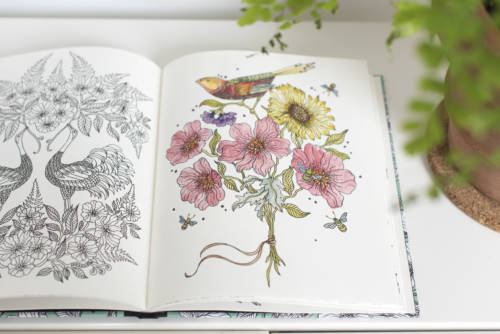
How Coloring Reduces Stress and Anxiety
All across the world, adults are getting in touch with their inner child. From Vietnam to Germany, France to Brazil, grown-ups are settling in at the kids table for some good old-fashioned coloring.
This international phenomenon began in 2013 with the publication of Johanna Basford’s Secret Garden: An Inky Treasure Hunt and Coloring Book. Basford’s work encourages a tactile experience of art; her labyrinthine illustrations are done exclusively in pen and ink, renouncing more modern, digital means of production. Intended for all ages, Basford’s work has found a dedicated following among adults: it has sold more than two million copies, been translated into 14 different languages, and inspired numerous spinoffs. Almost paradoxically, Secret Garden and other coloring books like it thrive in the era of social media, even as the deliberate attention and focus required to complete a single page seems at odds with endless scrolling through Instagram or Facebook.
“When I color, I enter a meditative state,” she explained. “It is easier than more traditional practices of meditation because there is a tangible format–the design–to guide you and keep you focused. Your mind can wander, but there is still a grounding task.”
In part, the success of adult coloring books can be attributed to the simple creative outlet they provide. Some people opt to color true to the illustration, while other, more abstract designs often inspire vivid, psychedelic works. Individuals’ different interpretations of a single page easily translate across cultures, and completed pages are displayed on Instagram where they can be viewed publicly. Unlike some other craft projects, coloring books are affordable and easy to transport, making them an ideal artistic activity that can be done almost anywhere.
Yet coloring can be more than just an aesthetic indulgence: studies have shown a reduction in stress in those who colored in a pattern compared to those assigned to unstructured coloring. Coloring mandalas (a geometric symbol native to Indian religions) has also been shown to reduce clinical cases of depression and anxiety when integrated into art therapy treatments. As an activity for children, coloring has long proven a calming project for quiet time.
As a practice, however, coloring also offers a balance of freedom and structure. Carolina Oliveira, a professional dancer and ballet teacher in New York City, spends most of the day on her feet, so exercise isn’t always the most appealing form of stress relief. Instead, she uses coloring as an alternative to unwind after a long day.
“When I color, I enter a meditative state,” she explains. “It is easier than more traditional practices of meditation because there is a tangible format–the design–to guide you and keep you focused. Your mind can wander, but there is still a grounding task.”
Coloring Basford’s elaborate etchings is a continual act of discovery. The garden materializes as the pages are slowly filled in, and the attention given to shading within the lines and selecting colors creates a kind of introspective, mindful state. Though intricate, the designs do not take excessively long to fill in, and there is a steady satisfaction to be found in completing each unique page.
The next time you’re feeling the stress of a long work week and need to decompress, grab your pens, crayons, or markers and paint the town red (or green or blue). Basford’s “secret garden” may not require sunshine or water to come alive, but that doesn’t make tending to its pages any less rewarding.



































